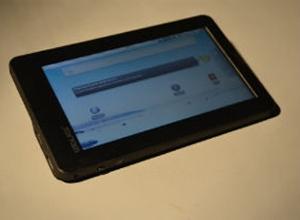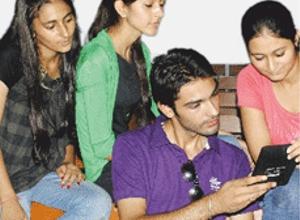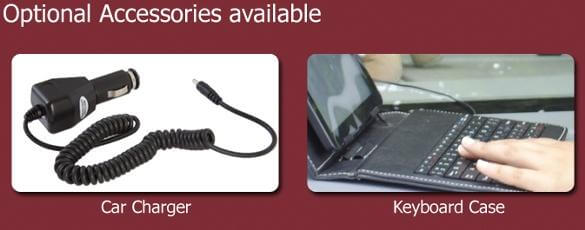
What’s the cost of a world class education? Less than $50. Thanks to the vision of Kapil Sibal, India’s telecommunications minister, there is now an Android enabled tablet computer that costs as little as 1500 rupees (about $30). Produced by Datawind Ltd, and “made in India”, the Aakash tablet is aimed to transform university level education and become a standard device among students on the subcontinent. It has a 7 inch resistive touchscreen capable of playing full HD movies, WiFi connectivity, a 366 MHz processor and many other impressive specs for its price. 10,000 are already in the hands of university students in India with 90,000 more arriving soon. 8-10 million will be shipped in the next five years! A retail version, called UbiSlate, will debut later this year at around 3000 rupees. See the Aakash in action in the video below. Between Datawind’s low-cost manufacturing strategy and Sibal’s dedication to the project, India has received a device that will open up new markets that were unlikely to be reached by big brands like Apple or Samsung. This isn’t the best tablet in the world, but when it comes to next generation computer use, sometimes the cheapest option wins.

There’s a lot of mixed messages about the details of Aakash out there. Depending on whether you go to the Wall Street Journal, Bloomberg, or Hindustan Times you’re going to get different quotes on the ultimate price. Here’s what I can say with some certainty: The retail price for Aakash/UbiSlate is almost definitely going to be 3000 rupees (~$60 USD). The discounted student price for the current Aakash models that have been released is around 1500 rupees ($30 or so), and that is due to a 50% government subsidy. But whether you want to call the Aakash a $22, $35, $50, or $60 tablet doesn’t matter. The bottomline is that this thing is dirt cheap, yet still reasonably powerful. The full specs of the UbiSlate are available to review online, but here are the highlights:
7 inch resistive touchscreen (800×480)
366 MHz processor
256 MB memory
2 GB storage (external expandable up to 32 GB)
WiFi connectivity
Mobile connectivity (through a dongle in early models)
2.0 USB port
180 minutes of battery life (1-2 hours if playing HD video)
Comes with Datawind’s UbiSurfer browser.
The NDTV exclusive look at the device in the video below has more details:
Now clearly the Aakash can’t compete with the iPad2, but it costs about one tenth as much (retail price in India is about 30,000 rupees). The first 10,000 delivered also didn’t have mobile connectivity (though the remaining 90,000 of the first order will). While it runs Android, it doesn’t have access to the Android Market, instead it will be setup with GetJar to give users about 150k apps to choose from. With a resistive (not capacitive) touchscreen Aakash won’t have multitouch, and its visibility won’t be that great. The three hour (180 minute) battery life is also a little disappointing.
But you know what? Who the hell cares. This is a tablet computer that will cost a student less than $35. That’s remarkable, and a welcome addition to the world market. For a long time Singularity Hub has been discussing (and cheerleading) the dawn of digital education. Well, a cheap but usable tablet computer is a great device to bring digital education to people who would never have had a tablet computer otherwise. We recently discussed the amazing impact cheap smart phones were having on sub-Saharan Africa. Well those smart phones were $80. This is a tablet for half that cost. Think of the possibilities here! Students from all over the world could have access to the Kahn Academy or even classes at Stanford. Beyond education, we could see this level of tablet serve as a new platform for commerce, news, social networking, and much much more. The most powerful applications for the Aakash/UbiSlate probably haven’t even been conceived of yet – they’ll arise organically as this device takes off in India and (eventually) around the world.

Sibal wants millions of Aakash devices to be available to students in the next few years, and millions more will be sold commercially in India at full price. Even if the product never goes beyond this initial market it will still be an important device because it showcases a growing paradigm: cheap connectivity and computing is likely to be as important (if not more important) than cutting edge computing. Ray Kurzweil and other futurists like to point out that when a technology first arrives it is always expensive and doesn’t work very well. It’s only when new tech reaches the masses that it makes a big impact. That may be where we’re at with tablet computers. There are billions of people in the world that will come online in the next few decades. These new users, located in Africa, Asia, and Latin America, aren’t necessarily going to be able to afford a $600 iPad. Cheaper devices, like the UbiSlate, may be the definitive platforms of the 21st Century in these lower end markets.
Which is why I like this next video. NDTV interviews Suneet Tuli, one of the founders of Datawind. He explains how the company was able to produce a workable tablet computer for a fraction of what competitors charge. Eschewing modules, they hunted down pieces of the tablet at the component level, saving a few dollars here and there (6:44). The video also starts off with a great discussion on the realities of globalization. Aakash is “made in India” but all products, no matter what brand they have printed on them, are really products of the world economy. Tuli’s description of that reality, and how it compares to the romantic notion of nationalistic production, is a calm and clear explanation you don’t want to miss.
(The inclusion of mobile connectivity for the Aakash is discussed around 6:15, for those interested).
I find the creation of the Aakash so meaningful because I know that it is just the first of its kind. Datawind has shown that Sibal’s vision is achievable, and from now on it (and its competitors) will continue to expand and refine that vision. We’ll get better mobile connectivity, better screens, a real Android Market, more battery life, etc, etc. The third world is hungry for a cheap tablet computer, and manufacturers are now able to provide them with one. It will be devices like the Aakash, cheap tablets and smart phones, that are likely to bring billions of more people online in the coming decades. If you think the internet is a breeding ground for innovation and disruption now, wait to you see what happens when the entire world is firmly online. I’m glad Sibal aimed this groundbreaking device at education first, but there are dozens of other targets that a cheap tablet can hit. Big changes are coming, and they’re not centered on the West. Hope you’re ready, true digital globalization is near.
[image credits: Hindustan Times, Ubislate (Datawind)]
[source: Datawind]



